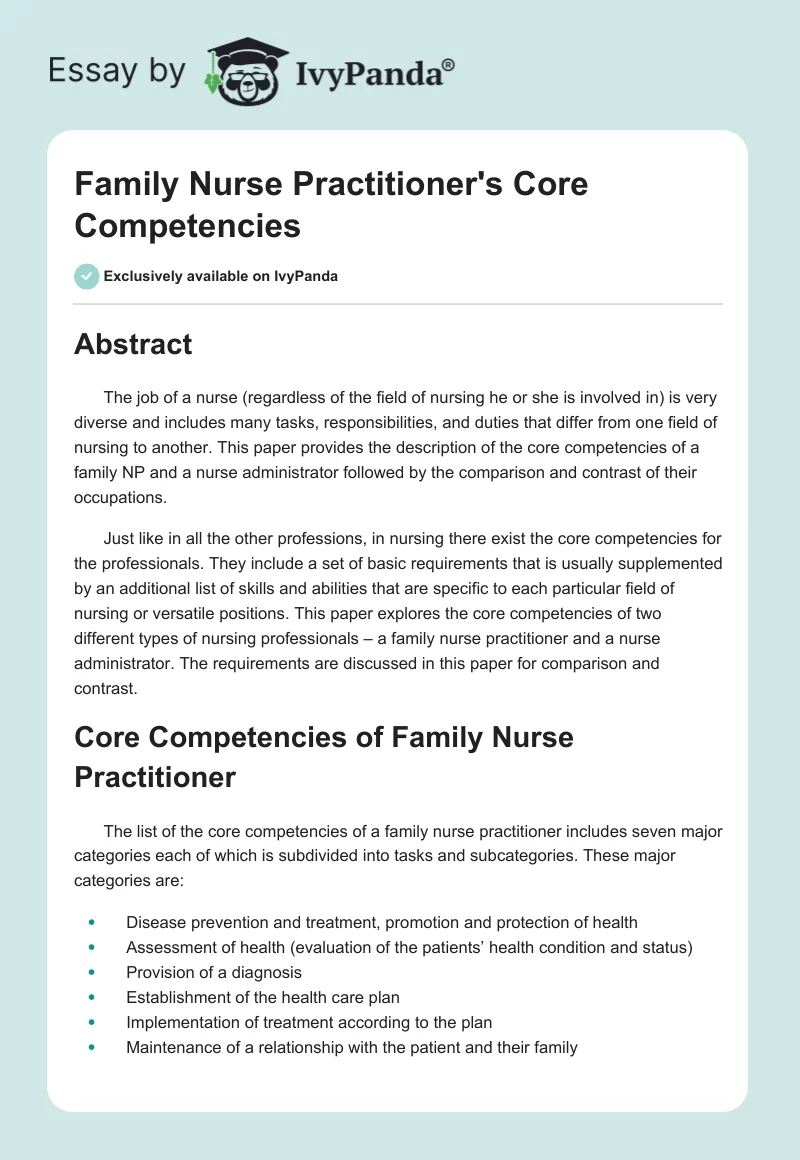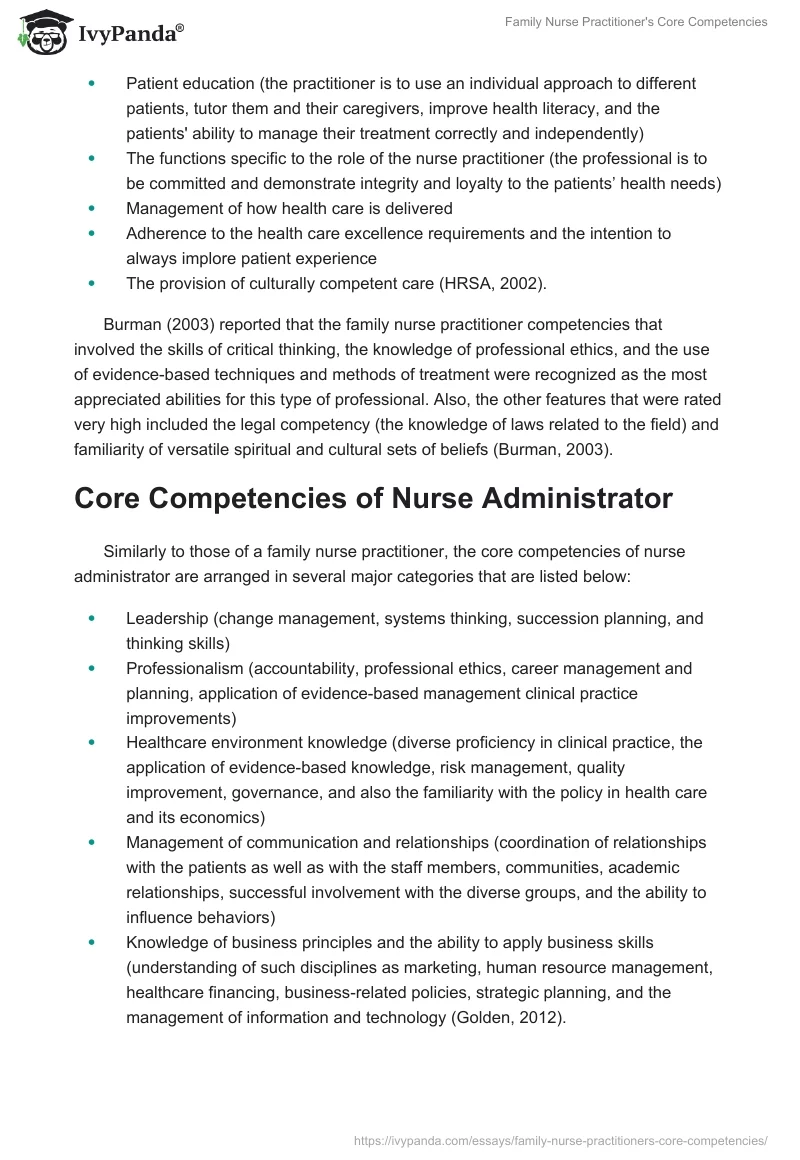Abstract
The job of a nurse (regardless of the field of nursing he or she is involved in) is very diverse and includes many tasks, responsibilities, and duties that differ from one field of nursing to another. This paper provides the description of the core competencies of a family NP and a nurse administrator followed by the comparison and contrast of their occupations.
Just like in all the other professions, in nursing there exist the core competencies for the professionals. They include a set of basic requirements that is usually supplemented by an additional list of skills and abilities that are specific to each particular field of nursing or versatile positions. This paper explores the core competencies of two different types of nursing professionals – a family nurse practitioner and a nurse administrator. The requirements are discussed in this paper for comparison and contrast.
Core Competencies of Family Nurse Practitioner
The list of the core competencies of a family nurse practitioner includes seven major categories each of which is subdivided into tasks and subcategories. These major categories are:
- Disease prevention and treatment, promotion and protection of health
- Assessment of health (evaluation of the patients’ health condition and status)
- Provision of a diagnosis
- Establishment of the health care plan
- Implementation of treatment according to the plan
- Maintenance of a relationship with the patient and their family
- Patient education (the practitioner is to use an individual approach to different patients, tutor them and their caregivers, improve health literacy, and the patients’ ability to manage their treatment correctly and independently)
- The functions specific to the role of the nurse practitioner (the professional is to be committed and demonstrate integrity and loyalty to the patients’ health needs)
- Management of how health care is delivered
- Adherence to the health care excellence requirements and the intention to always implore patient experience
- The provision of culturally competent care (HRSA, 2002).
Burman (2003) reported that the family nurse practitioner competencies that involved the skills of critical thinking, the knowledge of professional ethics, and the use of evidence-based techniques and methods of treatment were recognized as the most appreciated abilities for this type of professional. Also, the other features that were rated very high included the legal competency (the knowledge of laws related to the field) and familiarity of versatile spiritual and cultural sets of beliefs (Burman, 2003).
Core Competencies of Nurse Administrator
Similarly to those of a family nurse practitioner, the core competencies of nurse administrator are arranged in several major categories that are listed below:
- Leadership (change management, systems thinking, succession planning, and thinking skills)
- Professionalism (accountability, professional ethics, career management and planning, application of evidence-based management clinical practice improvements)
- Healthcare environment knowledge (diverse proficiency in clinical practice, the application of evidence-based knowledge, risk management, quality improvement, governance, and also the familiarity with the policy in health care and its economics)
- Management of communication and relationships (coordination of relationships with the patients as well as with the staff members, communities, academic relationships, successful involvement with the diverse groups, and the ability to influence behaviors)
- Knowledge of business principles and the ability to apply business skills (understanding of such disciplines as marketing, human resource management, healthcare financing, business-related policies, strategic planning, and the management of information and technology (Golden, 2012).
In the Healthcare Leadership Alliance Model, these competencies are presented in the form of a scheme with leadership category at the center, communication management, and professionalism – at the top, and environment and business knowledge – at the bottom (Golden, 2012).
Comparison and Contrast
The lists of the core competencies of both types of nursing professionals are similarly long and diverse. This aspect signifies that a nurse administrator and a family nurse practitioner both have very wide scopes of tasks and duties. At the same time, their roles differ significantly. The major tasks of the family nurse practitioner are related directly to communication and interaction with the patients and their families and involve the assessment of the clients’ health statuses, establishment of diagnosis, creation of a treatment plan, and education of the patients and their caregivers.
In contrast, the core competencies of a nurse administrator include the knowledge of a wider range of fields – for example, nurse administrator does not work directly with the clients, but his or her job is to consider such aspects of health care provision as quality improvement, risk management, and governance. Besides, the nurse administrator is involved in the process of interactions with the clients using coordinating and managing it. While the family nurse practitioner is focused specifically on the practice of health care delivery to the patients in need, the duties of a nurse administrator cover many different fields such as financing, policy administration, and implementation, case management, strategic and business planning, and the management and technology and information. It is possible to conclude that nurse administrator is more versatile as a profession and requires a much wider scope of knowledge whereas the practice of a family NP is concentrated directly on the work with the patients and the delivery of care.
References
Burman, M. E. (2003). Complementary and alternative medicine: core competencies for family nurse practitioners. Journal of Nursing Education, 42(1), 28-34.
Golden, M. A. (2012). The nurse administrator in long-term care. In A. McDonnell (Ed.), Managing Geriatric Health Services (pp. 25-44). New York, NY: Jones & Bartlett.
HRSA. (2002). Nurse practitioner primary care competencies in specialty areas. Web.


